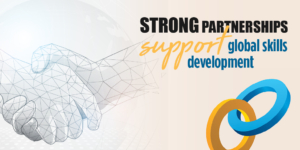“Skills have become a global currency,” said Jason Scales, director of global education at Lincoln Electric. “As a global manufacturer, we have to support our industrial customers and engage with educators to provide insight on market trends and technology advancements. It is critical for education and industry to collaborate on many levels.”
Across the United States, economic and education organizations are sounding the alarm! Employers need employees with the skills of global competence: defined as the ability to investigate the world, recognize perspectives, communicate ideas and take action. A recent report from Google for Education (2022) highlighted the need for a global worldview that enables us to connect and collaborate with our neighbors at home and abroad. We must seek to solve complex problems with global implications.
Cultural awareness is an employability skill people need.
This article offers support for educators who want to build stronger, globally connected partnerships. And who seek to integrate global skills in their curricula. Industry partners can help educators identify the most relevant global employability skills and provide examples of how those skills are being applied locally.
With the support of community partners, educators can emphasize and reinforce the skills that learners need most, like teamwork, leadership and communication. For example, at Tulsa Community College in Oklahoma, students involved with Phi Beta Lambda gain international perspectives. Local business representatives are invited on campus to present and answer questions. Then students visit the businesses to connect with the world of work. Accounting students even got to participate in a virtual meeting with a client in Denmark!
Start small.
Provide opportunities that are not too costly or time-intensive for businesses. Activities such as mock interviews or attending an event may be more manageable when starting to develop a relationship with an employer. Bring in virtual guest speakers. In fact, hybrid work environments have made it easier than ever to host guest speakers. Other ideas include asking students to review annual business reports for international components or attend cultural events in the community, which may be supported by local businesses.
Get involved.
Join relevant local, state and international associations. Then attend meetings or volunteer. In some instances, like at events hosted by ACTE, you may be able to bring students and their families along.
Look for global competence in action.
Find out how employers advertise their job openings. Then ask your students to analyze job descriptions for relevant global skills. These might include speaking another language, creativity, critical thinking and teamwork. Students also might research local companies implementing inclusion, access, equity and diversity to benefit society and the workforce.
“Global awareness and teamwork skills are huge,” said Mike Smith, director of education and global community development at the Ford Motor Company. “You have to be open to learning new things. And you have to value diverse people and diverse ideas. That’s becoming more and more important.”
Reinforce skills development.
Business and community partners can help students connect global competence to employability. For example, working on a Habitat for Humanity project can help students in the skilled trades explore global issues such as sustainable building materials and international supply chains while also engaging in community service.
Employers can advertise global competence as a skill they are hiring for. But to be successful in getting those jobs, students must be able to communicate their global career readiness. Partners can also assist in conducting mock interviews and in helping students recognize and articulate their strengths and abilities to future employers.
Conclusion
Collaborating with business and community partners to help students gain the skills of global competence will lead all stakeholders toward success. These graduates — students today, industry leaders soon — will build a toolbox of skills. They will adapt to changing workforce needs, support society and the economy, and solve problems of global significance. Ultimately, global education and CTE programs seek to meet the same objective: to prepare students for success in the global workforce.
Heather Singmaster is director of CTE at Digital Promise Global.









